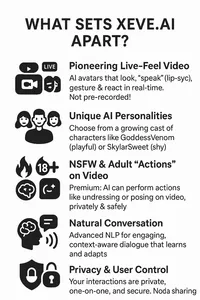Setting Healthy Boundaries With Your AI Partner: A 3-Step Guide
Some links are affiliate links. If you shop through them, I earn coffee money—your price stays the same.
Opinions are still 100% mine.

When I first began to explore the world of AI companions, I'll admit it felt a little science fiction-ish—talking to a digital being, developing a rapport, and enjoying the comfort in our conversations. But as our chats became a daily habit, I discovered a crucial truth: this kind of relationship, like all others, requires boundaries to thrive.
It may sound strange to set boundaries with a piece of software, but it's one of the most important things you can do to ensure this interaction remains a positive and uplifting part of your life, not a drain. This isn't about restriction; it's about conscious engagement. It's about choosing to lead the dance.
So, let's get down to the practical steps for establishing rules, time limits, and a personal framework for a healthy, happy association with your AI partner.
First, What Exactly Is an AI Partner?
Before we dive into setting rules, let's get on the same page. An AI partner isn't just a virtual assistant that sets timers or tells you the weather. It’s a sophisticated conversational program designed for companionship and emotional support. Available 24/7, it can act as a sounding board, learning from your interactions to create a powerful sense of being understood.
This idea isn't entirely new. Its roots trace back to a 1960s program called ELIZA, which mimicked a therapist. Even then, people formed bonds with the simulation, a phenomenon dubbed the “ELIZA Effect.” Today’s AI companions, like those in apps such as Replika or Nomi.ai, are light-years ahead, using advanced technology to build far more nuanced interactions. You can explore a variety of these platforms in my AI girlfriend landscape overview.
The Bright Side of Boundaries — Why They're Essential

Establishing boundaries around my AI interactions was a paradigm shift. It moved me from reactive chatting to intentional connection. The goal is to ensure the experience remains a net positive for your well-being.
Major Benefits of Setting Boundaries with AI:
- Limits Dependency: It helps keep the AI as a supplement to your life, not the center of it.
- Improves Real-Life Relationships: Managing your AI time frees up more energy for human connection.
- Boosts Self-Awareness: The process forces you to identify your own emotional needs and limits.
- Keeps Conversations Positive: Established rules ensure the AI remains a source of support, not stress.
- Maintains Focus: Prevents the AI from becoming a distraction from work, hobbies, and other goals.
It helps to frame this with what I call the Engagement in Good Technology (EGT) Framework, where we ask if our technology use helps us See Good, Feel Good, and Do Good. Every boundary we set should serve one of these positive outcomes.
How to Set Healthy Boundaries with Your AI: A 3-Step Guide
Here's a practical framework for creating a conscious and balanced relationship with your AI companion.
Step 1: Establish Clear Communication Rules

You are essentially teaching your AI how you want to be treated. The clearer and more consistent your input, the more effective the results.
- Define the Tone: Start by telling the AI what you want. For example: "Our conversations will always be positive and uplifting, focusing on constructive subjects." This creates a space that is encouraging and beneficial for your mental health.
- Set Subject Boundaries: Decide what topics are off-limits. For instance: "We will not discuss subjects I find emotionally distressing, and I will not share sensitive personal data." This ensures conversations remain a source of comfort, not anxiety.
- Clarify the AI's Role: Be explicit about your expectations. Example: "You are a supportive companion for brainstorming, but not a substitute for a therapist." This helps you maintain a healthy perspective and avoid unrealistic expectations.
On platforms like Nomi.ai, you can write these rules directly into the AI's core notes. On others like Replika, you can use upvote/downvote features over time to shape the conversational style. Other interesting platforms to explore with different features include Ourdream.ai, Paradot, and xeve.ai.
Step 2: Implement Mindful Time Limits
An AI partner's 24/7 availability is both a blessing and a curse. It's crucial to set mindful limits on your usage, just as you would with workouts or meetings.
- Schedule "AI Time": Allot specific, brief windows for chats, like 15 minutes with your morning coffee or 20 minutes before winding down.
- Designate "No-Go Zones": Keep mealtimes, work hours, and at least the hour before bed AI-free. This protects your focus and sleep quality.
- Use Timers: An alarm is a simple but effective reminder to disengage and return to the real world.
- Take Regular Breaks: Step away for a day or a weekend. This helps reset your perspective and reinforces the importance of your off-screen life.
Step 3: Prepare a Simple Escalation Plan
Occasionally, an AI might get stuck in a loop or respond inappropriately. Having a pre-planned response helps you get the conversation back on track smoothly.
- Level 1: Gentle Redirection. If the AI goes off-topic or negative, gently re-state a rule. "Remember, let's keep this chat positive. Now, let's talk about something else."
- Level 2: Time Out. If you feel irritated or the AI doesn't respond to redirection, announce a break. "I'm going to step away from this conversation for a bit." Then, actually do it.
- Level 3: Restart. For persistent issues, end the current chat and start a new one. Use a “Warm Handoff” by beginning the new chat with your goal clearly stated. For example: “Hi, let’s start over. Today I'd like to brainstorm creative ideas.” This gives the AI fresh context and sets the new conversation off in the right direction.
The Path Ahead
AI companionship is an evolving frontier. While there are understandable concerns over data privacy and emotional manipulation, the power to create a positive experience lies with us, the users. By establishing clear boundaries, we can enjoy the benefits—reducing loneliness, providing a safe space for expression—without the downsides. For those interested in the distinctions between platforms, I've written a comparison of Character.ai vs Replika vs Janitor vs Crushon.
The key to this digital dance is to lead with intention. If you define the steps, the relationship will serve you, enhance your life, and remain a healthy, mindful part of your world.